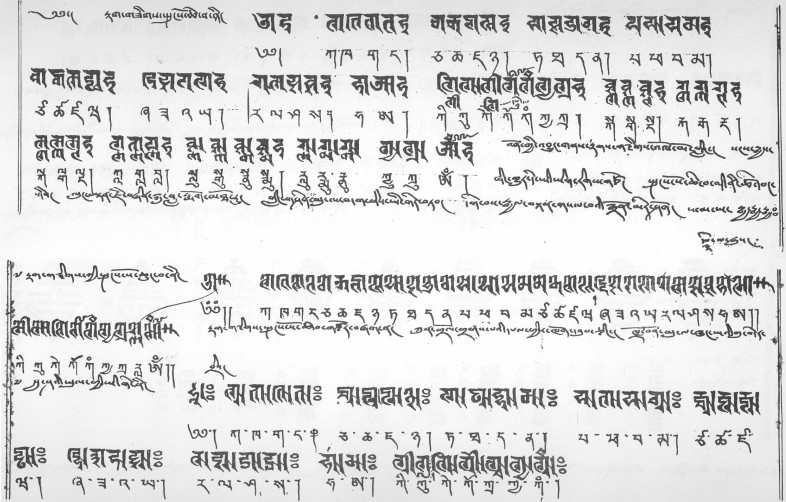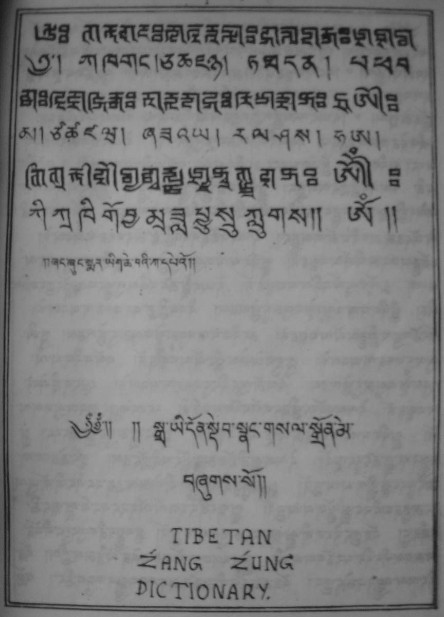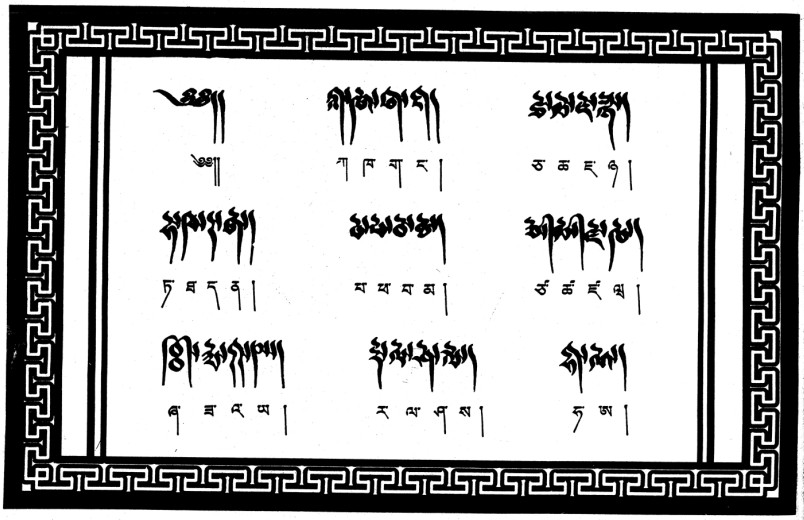BabelStone Blog
Sunday, 27 May 2007
Zhang Zhung Scripts
The Zhang Zhung ཞང་ཞུང culture (pronounced shang shung in the modern Lhasa dialect) is an ancient culture that flourished in the western and northern parts of Tibet before the introduction of Buddhism into the country during the 7th century. For a long time there was little concrete evidence of the existence of the Zhang Zhang kingdom described in Tibetan sources, and it was regarded as semi-legendary by some Western scholars, but in recent years archaeological investigation has confirmed the existence of an extensive early Tibetan culture that has been identified with that of the Zhang Zhung.
Although the Zhang Zhung kingdom ceased to exist as a separate entity after the unification of Tibet under King Songtsän Gampo, the adherents of the Bön བོན religion claim to be the inheritors of the Zhang Zhung culture, and many of the texts in the Bön canon are putatively translated from the Zhang Zhung language. From what I understand, there are not many extensive examples of texts written in the Zhang Zhung language still extant. There are some examples of Zhang Zhang dharani, and the the Zhang Zhung titles of works translated into Tibetan are often preserved, but the only lengthy bilingual text in Zhang Zhung and Tibetan is the mDzod-phug མཛོད་ཕུག, a work on cosmogony, theogony, and cosmology. In addition to the Zhang Zhung texts preserved in the Bön tradition, there are a few fragments from Dunhuang that may be written in the Zhang Zhung language. Based on the surviving examples of Zhang Zhung texts it would seem that the Zhang Zhung language is a distinct language related to but separate from Old Tibetan. A lot of work has been carried out on the Zhang Zhung language in recent years, and there are a number of Zhang Zhung / Tibetan glossaries in existence, but unfortunately none of them are freely available on the internet yet.
The Bön tradition is also the source for a number of different scripts that were supposedly used to write the Zhang Zhung language and the languages of other ancient cultures :
- the sMar-chen སྨར་ཆེན or Greater sMar script
- the sMar-chung སྨར་ཆུང་ or Lesser sMar script
- the sPungs-chen སྤུངས་ཆེན or Greater sPungs script
- the sPungs-chung སྤུངས་ཆུང་ or Lesser sPungs script
- the Bru-sha བྲུ་ཤ script
The Greater and Lesser sMar (silent s) scripts are known collectively as sMar-yig སྨར་ཡིག "the sMar script", and supposedly originate from the ancient kingdom of Zhang Zhung. The word smar means "money, cash" in Tibetan, but here it probably represents the Zhang Zhung word smar, meaning "good" or "beautiful" (corresponding to Tibetan bzang བཟང་). Thus sMar-yig is the good or beautiful script.
The Greater and Lesser sPungs (silent s before and after) scripts are known collectively as sPungs-yig སྤུངས་ཡིག "the sPungs script", and supposedly originate from the legendary kingdom of sTag gZig(s) སྟག་གཟིག or སྟག་གཟིགས (silent initial s and g) to the west of Zhang Zhung, which was the original home of the Buddha-like founder of the Bön religion. The name sTag gZig literally means "tiger-leopard" in Tibetan, and is an alternate form of ta-zig ཏ་ཟིག, which most scholars presume represents Tajik, an ancient name for Persia (cf. medieval Chinese da shi 大食 *dɑ dʑĭək). However, there is considerable debate about exactly where the country of sTag gZig lay. The word sPungs means "heaped up" in Tibetan, but in the Zhang Zhung language it is equivalent to Tibetan ston-pa སྟོན་པ "teacher", specifically the great teacher Tönpa Shenrab སྟོན་པ་གཤེན་རབ, legendary founder of the Bön religion. Thus sPungs-yig is the script of the Teacher.
The Bru-sha (pronounced drusha) script supposedly originated from the country of Bru-sha བྲུ་ཤ (also Bru-zha བྲུ་ཞ or Bru-tsha བྲུ་ཚ), which is commonly identified with Gilgit in Pakistan on the basis that bru sha represents Burushaski.
Thus, the more proper title of this post should have been Scripts from Zhang Zhung, sTag gZig and Brusha, but for simplicity I will refer to all the scripts used in Bön texts as Zhang Zhung scripts, as they are all associated with the Zhang Zhung culture.
It is claimed by Bönpos (Bön practioners) that these are ancient scripts predating the introduction of Buddhism into Tibet and the invention of the Tibetan script. Indeed, it is commonly stated that the Tibetan dbu-med (silent d, b and d) "headless" script favoured by Bönpos is derived from one or other of the Zhang Zhung scripts. However, sceptics have suggested that these scripts were invented by Bönpos in order to give a simulacrum of antiquity to "discovered" Zhang Zhung texts and to make the Bön religion appear more ancient than its rival Buddhism. Certainly, when you look at these scripts they appear to be closely related to or derived directly from the Lantsa script or Tibetan script, and it is very hard to believe that they originated from outside of Tibet hundreds of years before the invention of the Tibetan script. The specific claim that one or other of these scripts is ancestral to the Tibetan dbu-med "headless" script is, in my opinion, complete nonsense, as the dbu-med script is quite evidently a cursive development of the standard dbu-can "headed" book form of Tibetan letters, and has no obvious relationship to any of the Zhang Zhung scripts that I know of.
There is virtually no concrete information on Zhang Zhang scripts publicly available on the internet (the only sample of a text written in a Zhang Zhung script that I have been able to find are these two examples, which appear to be written in the sMar-chung script), so when Chris Fynn kindly provided me with a number of Zhang Zhung script samples recently I thought it would be useful to try to make some sense of the different scripts. Given the lack of available resources it has not been easy, and I am sure that I have made mistakes and missed out important details, but when I get more information on the scripts (and hopefully get some actual texts written in Zhang Zhung scripts) I will update this post.
I have made available samples of all five Zhang Zhung scripts at my new Zhang Zhung scripts page, which I suggest anyone interested in Zhang Zhung scripts reads in conjunction with this post. I will therefore only show a couple of sample images here. For ease of comparison of the scripts I have also made available tables of letters for the sPungs-chen, sPung-chung and Bru-sha, sMar-chen and sMar-chung scripts.
One interesting web site is Lantsha, Vartu and other Indic Scripts, which has sections on Zhang-zhung script (actually the sPungs-chen script, but elsewhere samples of sPungs-chen and sPungs-chung calligraphy are given) and Smar Script. However the letterforms of the "Smar script" shown on this site are completely different from those in any of the sMar-chen or sMar-chung script samplers that I have seen, and are probably not sMar-yig script in the strict sense. They perhaps represents the esoteric script known as lha-bab yi-ge ལྷ་བབ་ཡི་གེ "letters of descended gods" that is often confused with the sMar-yig script. The author of this site has made fonts for all the scripts shown, but they do not appear to have been made freely available.
sPungs-chen, sPungs-chung and Bru-sha Scripts
sPungs-chen (top), sPungs-chung (middle) and Bru-sha (bottom)
Indian Scripts in Tibet (New Delhi, 1982) p.59
These three scripts are all very similar, and would seem to be closely related. There is a strong similarity between them and the Lantsa or Lanydza script, which is commonly used in Tibet for writing Sanskrit. Several sPungs-chung letters are virtually identical to the corresponding Lantsa letterform (e.g. Pa, Pha, Ma and La, and note also sPungs-chen letter Sa which is exactly identical to Lantsa letter Sha), and several others differ from the corresponding Lantsa letterform only by the addition of a final vertical stroke (e.g. Cha, Ta, Da, Ra, Ha and A, but note that the letters Ta and Da correspond to the retroflex letters Ṭa and Ḍa in Lantsa). However, there are some interesting differences between the sPungs scripts and Lantsa, for example the vowel sign "i" is on the left in Lantsa but on the right in the sPungs and Bru-sha scripts, and the sPungs-chen and sPungs-chung scripts (but not Bru-sha) have a very peculiar snake-shaped "o" vowel sign.
The sPungs-chung letters are basically the same as sPungs-chen letters, with some minor stylistic differences (for example the stroke that forms the head of the letter is straight in the sPungs-chen script but bends down to the left in most letters of the sPungs-chung script; and the final vertical stroke found in many letters joins smoothly to the main body of the letter in the sPungs-chen script but is joined with an oblique stroke in the sPungs-chung script). The only significant difference between sPungs-chung and sPungs-chen is that they have completely different-shaped shad marks.
The letters of the Bru-sha script are also mostly very similar to those of the sPungs-chen script, but there are some letters (e.g. the letters Nya, Ya and Sa) that do differ significantly from the corresponding letterform in the sPungs-chen script. Furthermore, whilst the vowel signs for "i" and "e" are the same as for sPungs-chen and sPungs-chung, the vowel signs for "u" and "o" are not : the vowel sign for "o" is the same as the corresponding sign used in the sMar-chen and sMar-chung scripts; and the vowel sign for "u" is similar but not quite identical to the corresponding sign used in the sMar-chen and sMar-chung scripts. The most significant difference between the Bru-sha script and the sPungs scripts is that in the table of letters from Indian Scripts in Tibet shown above most of the Bru-sha letters (all except Za, Ki and Ku) are shown with an extra vertical stroke at the righthandside, joined to the main body of the letter with a short oblique stroke. As the corresponding Tibetan letters are shown with a tsheg mark (unlike for the table of letters for the sPungs-chen and sPungs-chung scripts) I think that the hook-like mark on the Bru-sha letters may be equivalent to a tsheg mark (i.e. mark the end of a syllable), and so should only be present on letters in a syllable-final position. The sMar-chung script also has a similar hook on the righthand side of letters which seems to correspond to a tsheg mark, but in the absence of any samples of running text written in the Brus-sha script it is not possible to be certain about the function of this hook-like mark in the Bru-sha script.
sMar-chen Script
sMar-chen Script
sGra yi don sdeb snang gsal sgron me སྒྲ་ཡི་དོན་སྡེབ་སྣང་གསལ་སྒྲོན་མེ by Zhu ston nyi ma grags pa ཞུ་སྟོན་ཉི་མ་གྲགས་པ [1616-1670] (Delhi, 1965) p.1
The sMar-chen script is completely different from the sPungs scripts, and other than the "i" vowel sign (and perhaps the letter Ka) there is no obvious relationship with the Lantsa script. A couple of the letters are quite close to the corresponding Tibetan letters (e.g. Nga and A), but most of the letters are quite unique in form and are not obviously related to the corresponding Tibetan letterforms.
One peculiarity of the script is the prominence of the swastika shape: the left-facing swastika occurs in the headmark and the letter Nya; and in one example of the script (but not so in other examples) the letter Ha is written as a right-facing swastika. This reflects the fact that the left-facing swastika (Tibetan g.yung drung གཡུང་དྲུང་ and Zhang Zhung drung mu) is the most important symbol of the Bön religion.
[2007-06-02: I have now released a sMar-chen style OpenType font -- see BabelStone Tibetan sMar-chen for details. This page also shows some photos of inscriptions in the sMar-chen script on buildings at the Dolanji Monastery.]
sMar-chung Script
sMar-chung Script (?)
Yig rigs zhang zhung ཡིག་རིགས་ཞང་ཞུང་ p.310
The sMar-chung script is closely related to the standard Tibetan dbu-can script. Although some letters are significantly different from the corresponding Tibetan letterforms (e.g. Nga, 'a, Ya, Ra, Sha, Sa and A), most sMar-chung letters are very similar to the corresponding Tibetan letter, but with an extra hook at the right, and in some cases (the Ca, Ta, Pa and Tsa series) an extra hooked stroke at the top of the letter as well. I think that the hook on the right corresponds to a tsheg mark (marking the end of a syllable), and so should only be present on letters in a syllable-final position. This feature links the sMar-chung script to the Bru-sha script, which also has a very similar hook-like mark at the righthandside of most letters. Although there is very little similarity in glyph shape between sMar-chung letters and Bru-sha letters, one other very significant correspondence between the two scripts is that they share the same four vowel signs, two or which ("i" and "e") are the same as in the sPungs-chen and sPungs-chung scripts, and two of which ("u" and "o") are the same as in the sMar-chen script. These features suggest that the sMar-chung script is a hybrid, with letterforms based on the Tibetan script but with vowel signs and the appended tsheg mark borrowed from the Bru-sha script.
Note that the script example shown above may or may not be written in the sMar-chung script. The letterforms are mostly very similar to those given in the example of sMar-chung script given in Indian Scripts in Tibet, with the same distinctive hook at the right of each letter, although there are a few letters which are different (e.g. Zha and 'a), and the vowel signs for "i" and "e" are not the same. Nevertheless, it is close enough to the for me to think that it is a rather fancy style of the sMar-chung script.
[P.S. You can see some examples of the modern usage of the sMar-chen script for transliterating Tibetan in this post.]
Index of BabelStone Blog Posts


